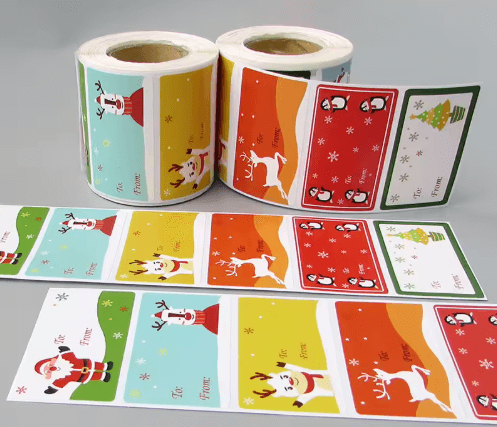Self-adhesive labels (also known as pressure-sensitive labels, instant labels, sticker labels) are composite materials made from paper, film, or specialty face stock coated with adhesive on the back and protected by a silicone release liner. After printing, die-cutting, laminating, and other finishing processes, they become widely used product labels across nearly all industries.
Major Industries Using Self-Adhesive Labels
1. Packaging Industry
Typical applications include:
- Shipping labels
- Postal parcel labels
- Letter and envelope labels
- Cargo identification labels
- Address and logistics barcodes
2. Consumer Goods Industry
Self-adhesive labels play a key role in retail and daily-use goods:
- Price tags
- Product description labels
- Shelf labels
- Barcode labels
- Pharmaceutical retail labels
3. Chemical Industry
Used for containers requiring strong durability and chemical resistance:
- Paint and coating labels
- Gasoline and engine oil labels
- Solvent-resistant labels
4. Electronics & Appliances Industry
Electrical products require high-durability labels:
- Electrical appliance rating labels
- Warning labels
- Compliance and certification labels
- Large-area machine labels
These labels require heat resistance, abrasion resistance, and long-term durability.
5. Logistics & Supply Chain Industry
With the rapid expansion of logistics, demand for variable data labels continues to grow:
- Storage & warehousing labels
- Transportation labels
- Luggage tags
- Supermarket thermal labels
6. Pharmaceutical Industry
Pharmaceutical packaging increasingly adopts self-adhesive labels due to safety and regulatory needs:
- Drug bottle labels
- OTC labels
- Childproof labels
- Barcode traceability labels
General Characteristics of Self-Adhesive Labels in Cold Environments
Winter and low-temperature environments significantly affect label adhesion. Many customer complaints—such as label falling off, slippage, or weak adhesive—are directly related to low temperatures.
Below are the key guidelines for using self-adhesive labels in winter.
Key Points for Using Self-Adhesive Labels in Winter
1. Proper Label Storage Temperature
Low temperatures may cause:
- Frost damage
- Hardened adhesive
- Loss of tack or bonding strength
Solution:
Store label materials at 15°C or above for at least 24 hours before use to restore adhesive performance.
2. Processing Environment Temperature
During printing and converting (die-cutting, slitting), low adhesive tack can cause:
- Printing defects
- Label misalignment
- Die-cutting slippage
- Label detachment during rewinding
Recommended temperatures:
- Summer-grade labels: ≥ 15°C
- Winter/transition labels: 10–20°C
3. Labeling Environment Temperature
Adhesives have a minimum application temperature. Below this threshold:
- Labels fail to bond
- Peeling occurs easily
- Label slippage increases
Recommended temperatures:
- Summer labels: ≥ 15°C
- Winter-grade materials: 10–20°C
4. Label Pretreatment is Essential
If labels become too cold during transport or storage—even if the labeling environment meets temperature requirements—adhesion may still fail because the adhesive has not warmed up internally.
Solution:
Place labels in the required temperature zone before use, allowing adhesive strength to fully recover.
Correct Use Ensures Reliable Performance in All Seasons
Self-adhesive labels are indispensable across multiple industries—from logistics and consumer goods to pharmaceuticals and electronics. Understanding their performance characteristics, especially in low-temperature environments, ensures that labels maintain proper adhesion, durability, and reliability.



